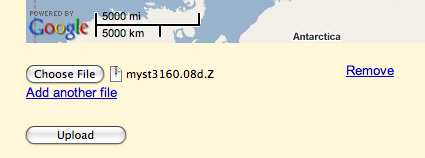December 10th, 2008 by Álvaro Mozo
From the 10th to the 12th of December, 2008, we are showing magicGNSS Beta at GMV’s booth in NAVITEC 2008 at ESTEC, the European Space Agency centre in Noordwijk, The Netherlands.
We are doing live demos of the new *pro* features, including the ability to upload and process your own data and to compare orbits.
If you are attending the workshop, don’t forget to check us out there!

magicGNSS at NAVITEC 08



Tags: Events
Posted in Events | Comments Off on magicGNSS Beta at NAVITEC 2008
December 10th, 2008 by Ricardo Píriz
We have just made available online the first version of the COMP module. COMP is envisaged to be a flexible tool to compare many types of GNSS data products such as orbits, clocks, and coordinates.
With the current version of COMP you can inter-compare estimated and predicted satellite orbits (in SP3 format) generated by the ODTS algorithm, and also compare them with IGS products.

Read the rest of this entry »
Posted in Announcements, Help, Tips & Tricks | Comments Off on Comparing results with COMP
November 28th, 2008 by Ricardo Píriz
You can now upload and process your own station data (RINEX files). There are two ways to upload RINEX files: on the web (for all users) or by ftp (for *pro* users only).
On the web, just go to “My Stations” on the upper right corner of your account and then click on “Upload RINEX files” at the bottom of the page. Note that a single compressed file containing multiple RINEX files is supported.

By ftp, just connect to the magicgnss.gmv.com server using your magicGNSS account’s username and password. You can of course do bulk file upload and automate it using ftp. On UNIX, a convenient scheme is to combine NcFTP (ncftpget and ncftpput commands) with cron. Ftp upload is available for *pro* users only. Please note that in case of uploading your RINEX files via ftp on Windows, after logging with your user, command “bin” shall be executed prior to uploading the RINEX files by means of “put” or “mput” commands. Read the rest of this entry »
Posted in Announcements, Help, Tips & Tricks | Comments Off on How to upload station data
November 27th, 2008 by Ricardo Píriz
As from today you can become a *pro* magicGNSS user! As a *pro* user you will be able to use magicGNSS for professional applications, having access to advanced features like:
• GLONASS data processing in ODTS and PPP
• Automated processing with the Scheduler
• Extended disk quota for user station data and processing scenarios
• Extended availability of GPS orbit and clock products from IGS for PPP processing
• Extended availability of core station data from IGS for ODTS processing
• Possibility to process user stations in ODTS (mixed with core stations or user stations alone)
• Increased number of stations and maximum data span in PPP and ODTS processing
• Ftp upload
• Share your station data
• Permanence of user station data in the user account (no deletion of RINEX files)
• Technical support by e-mail on a next-day basis

To become a *pro* user we need to agree on some license terms, just drop us a line at the contact e-mail address visible from within your magicGNSS account.
Posted in Announcements | Comments Off on Become a *pro* user!
October 20th, 2008 by Álvaro Mozo
Have you ever noticed that a satellite you configured in magicGNSS Beta is missing in the ODTS outputs and report? If this is the case, the satellite was likely unavailable during the configured dates.
As a GNSS user, you may be familiar with the NANUs. NANUs are messages published by GPS operators to inform about events occurring to the GPS constellation (such as maneuvers, on-board equipment maintenance, decommissioning, etc) affecting satellite availability.
magicGNSS needs to know about satellite availability, in particular those events that would affect ODTS, namely:
- New satellites declared active
- Existing satellites being decommissioned
- Satellites being manoeuvred
In order to achieve this, magicGNSS automatically gets NANUs as they are issued, parses them, extracts the relevant satellite availability information and stores it in its database. This is not a trivial issue, as there are 12 types of NANUs, according to the information they provide: the type of outage, whether it is scheduled or not, or other type of information. All the historic information is kept, so each ODTS execution will only consider satellites available in the scenario defined by the user no matter the dates selected!
Tags: ODTS, Tips & Tricks
Posted in Tips & Tricks | Comments Off on About GPS’ satellite availability










